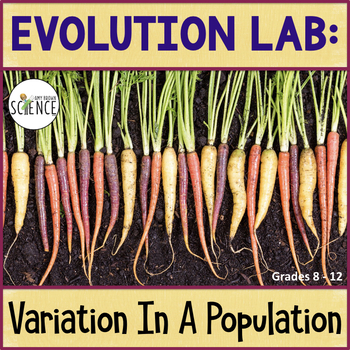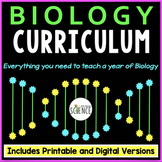Evolution Lab Activity Variation in a Population
- Zip
What educators are saying
Also included in
- Nothing generates excitement like a great lab activity. Whether the topic is cells, biochemistry, genetics, mitosis, or the compound microscope, these 15 Must-Do Labs will ensure your students master the concepts. From DNA to dichotomous keys to enzymes, this bundle provides quality lab activities oPrice $35.99Original Price $49.99Save $14.00
- This NO PREP, PRINTABLE, EDITABLE, AND DIGITAL Biology Curriculum contains everything you need for an entire year of Biology! For less than $3 a day, you can save your time, energy, and sanity. Each of the 20 Complete Units includes a teaching PowerPoint presentation, notes, labs, homework assignmenPrice $525.00Original Price $988.18Save $463.18
- This "Population Genetics Complete Unit Bundle" includes everything you need to teach a unit on "The Evolution of Populations" to your life science or biology students. Many of the resources are available in BOTH printable and digital formats. The bundle contains a 94-slide PowerPoint presentation,Price $39.99Original Price $50.23Save $10.24
Description
In this evolution lab activity, students will learn how the variations within plant and animal populations can be measured and why variation is essential to the process of evolution. Sexually reproducing parents produce offspring that are different from the parents and different from the other offspring. No two members of a species are exactly alike. These small differences in traits are called variations, and without them, evolution does not take place. In this lab, students will explore several variations in plants and animals, and will learn why variation is crucial to the process of evolution.
Purpose of the Lab:
- To quantitatively measure the variations in leaves, seeds, and human hands.
- To determine how variations are helpful in a population.
Materials List:
- 10 Red Kidney Beans (dry seeds)
- 10 Leaves
- Human hand
- Metric Ruler
- Colored pencils
What is included in this product?
- 8-Page EDITABLE Student Handout that is ready to be printed and passed out to your students. Students can write on the handouts or use their own notebook paper.
- Complete instructions.
- Data tables, graphing grids, analysis questions.
- 8-Page Teacher Guide containing tips, tricks, and suggestions.
- Complete Answer Key.
- Everything you need for the successful completion of this lab.
What will the students be doing?
- Students will mathematically measure several easily observable variations.
- Students will be measuring the lengths of seeds, the lengths of the petiole and blade of leaves, and the span of a human hand.
- This lab reinforces the skills of data collection, measurement, compilation of class data, graphing, and data analysis.
This lab activity is appropriate for biology students in grades 8 - 12.
Related products include:
Population Genetics and Speciation PowerPoint and Notes
A Hardy Weinberg Lab Simulation Activity
Hardy-Weinberg Practice Problems
Population Genetics, Hardy-Weinberg, and Speciation Task Cards
Population Genetics Crossword Puzzle
Population Genetics, Hardy-Weinberg, and Speciation: Set of 3 Homework Assignments
Evolution of Populations: Set of 3 Quizzes
The Evolution of Populations (Population Genetics) Unit Text
Genetics Complete Teaching Bundle
Evolution and Classification: Warm Ups, Bell Ringers and Interactive Notebooks
Darwin's Theory of Evolution PowerPoint and Notes
Lab: The Hardy Weinberg Equation
For updates about sales and new products, please follow my store:








